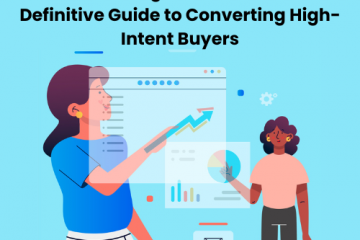AI Lead Generation: From Volume to Precision in 2025 and beyond
Sales has always been a numbers game. You have probably heard it a gazillion times from sales trainers, account managers, revenue leaders, and their grandmothers. As summed up by George W. Dudley in his book, The Psychology of Sales Call Reluctance, “success in sales is determined by the number of contacts initiated with prospective buyers on a consistent basis.”
For decades, sales success was measured by call volume and email blasts—a brute-force approach that cast the widest net possible, hoping to catch the fish. Result? Inefficient sales processes with no predictable pipeline value, leading to unscalable business growth.
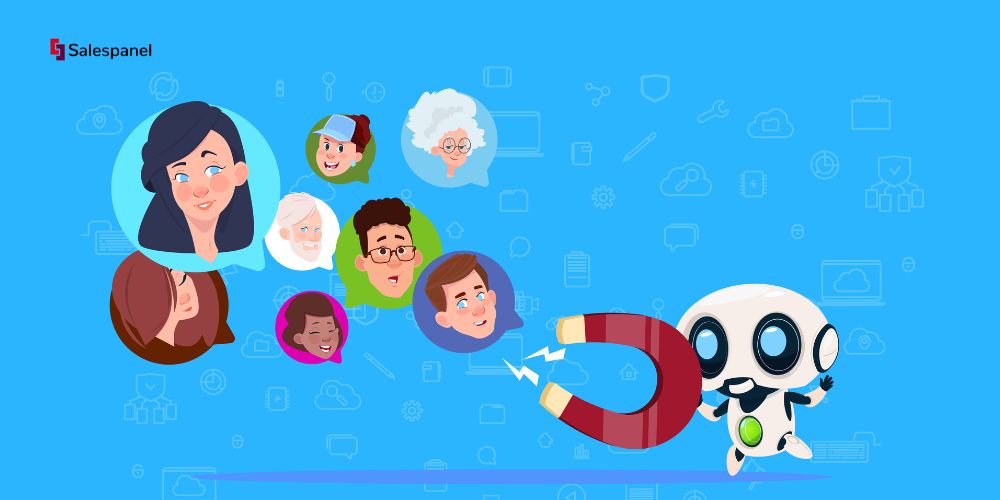
However, the sales landscape is drastically different in 2025. We now stand at a technological inflection point, where the future of sales isn’t about working harder; it’s about working smarter. So, what is pushing this shift? The answer is AI, or artificial intelligence.
Businesses leveraging AI for sales have reported seeing a 50% increase in leads and appointments, a 60-70% improvement in call times, and a 40-60% reduction in costs, according to a study by McKinsey. This shift from volume to precision is happening right now, and as a sales leader, it is the perfect time to cash in on the opportunities AI can bring to your business.
In this article, we will provide a technical breakdown of the mechanisms of AI lead generation—from machine learning to natural language processing—and their various use cases, such as customer behavior analysis, hyper-personalization, and dynamic lead scoring.
But first, let’s understand what AI in lead generation even means and why it matters right now.
The Role of AI in Lead Generation: Quick Overview
For decades, sales methodologies relied on a blend of gut feeling, manual list-building, and sheer volume. However, this approach is being rapidly outpaced by the precision and efficiency of AI-powered strategies that analyze data at a scale no human team could ever match.

This is what AI lead generation is all about—providing sales teams with the intelligence to understand who is ready to buy, what their specific pain points are, and when the optimal moment is to engage—creating a competitive advantage that can put you ahead of the curve.
Integrating AI into your business can achieve quantifiable improvements, such as:
- Increased Efficiency: AI automates repetitive, low-value tasks, such as prospect research, data entry, and initial outreach, thereby liberating sales professionals to focus on high-value activities, including strategic consultation and deal closure.
- Enhanced Personalization: By decoding the digital footprints of prospects, AI enables personalization at scale, tailoring messaging to individual needs and interests.
- Improved Lead Quality: AI algorithms sift through thousands of data points including demographic, firmographic, and behavioral attributes, to identify leads exhibiting genuine buying intent, saving salespeople time from wasting their efforts on low-quality leads.
But why does this matter right now?
The adoption of AI-powered sales is gaining momentum worldwide. AI tools are now recognized for their capabilities to analyze large datasets, forecast buyer habits with as much accuracy as possible, and provide immediate, personalized outreach.
The result is a pipeline of higher-quality leads and a more efficient marketing engine.
In case you have any doubts about such claims, we have industry analysis that corroborates the growing influence of AI in lead generation. As highlighted in a recent report by Amra and Elma, 79% of B2B marketers actively use AI in lead generation, integrating it seamlessly with CRMs to drive smarter automation, attract sales-qualified leads, and improve sales outcomes.
In the following sections, we will explore the three primary use cases of AI in lead generation—customer behavior analysis, predictive lead scoring, and hyper-personalization.
How AI Actually Finds Your Next Customer
To understand the mechanics of AI lead generation, you must examine its three core components—machine learning, natural processing, and predictive analytics—which form the foundation of any intelligent sales system.

Decoding Data with Machine Learning Models
Machine learning (ML) models serve as tireless analysts, reading supplied datasets and extracting valuable insights from them.
In this scenario, you feed it historical sales data—every initial touchpoint, closed-won deal, and lost opportunity. The model then processes thousands of variables to identify the subtle patterns and correlations that distinguish a high-potential customer from a dead end.
Practical Example: An ML model trained on an eCommerce retailer’s transaction and browsing data might detect that customers who add items to their wishlist, return to the website within 48 hours, and view the shipping policy page are 60% more likely to complete a purchase during a weekend sale. The model discovers this multivariable correlation autonomously, without being specifically programmed with this rule.
Once trained, the model applies this learned intelligence to new leads in real time. As a new prospect enters the funnel, the ML algorithms instantly assess their profile and behaviors against its established patterns to generate a predictive lead score, ensuring sales teams consistently prioritize the most promising opportunities.
Understanding Intent with Natural Language Processing
Customers don’t talk in numbers now, do they? The most valuable customer insights can be found in unstructured text, such as emails, social media, support tickets, and chatbot logs. This is where Natural Language Processing (NLP) comes in.
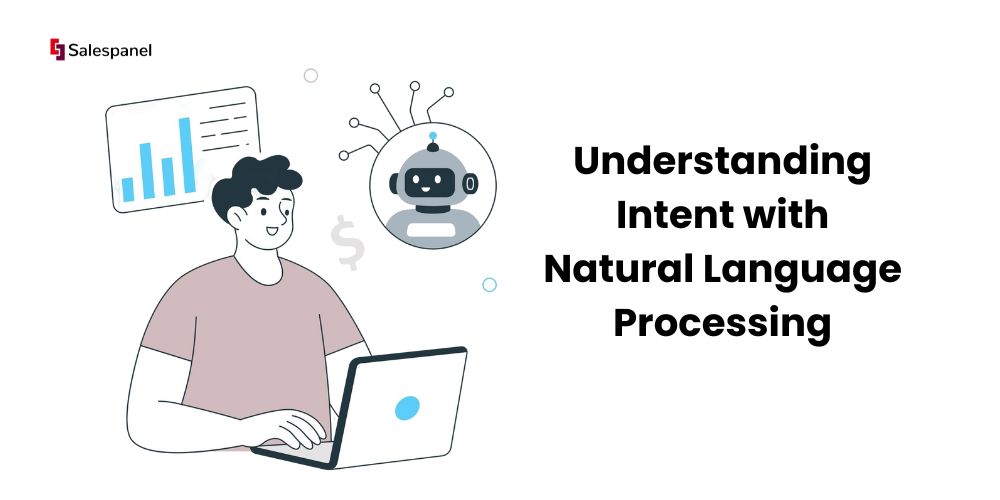
NLP allows an AI to move beyond simple keyword matching to understand the intent and sentiment behind a prospect’s words, deciphering context, tone, and emotional nuance.
Practical Examples:
- Sentiment Analysis: An AI platform can monitor social media for mentions of a competitor’s product. In case it detects a post expressing frustration with a specific feature (“Competitor X’s API integration is a nightmare”), the NLP mechanism can flag the author as a warm lead for a sales representative to contact with a tailored solution.
- Topic Extraction: Analyzing the text from a prospect’s email inquiries with NLP can help identify customers’ primary pain points. For instance, if the terms “integration challenges” and “data security compliance” repeatedly appear, the AI can empower the sales rep with relevant documentation before they even initiate a conversation.
- User Intent Recognition: Picture this—a website visitor types into a chatbot, “How does your pricing compare to Company X for an enterprise plan?” An NLP model can recognize this as a high-intent buying signal and can automatically route the conversation to a senior sales specialist for immediate engagement, increasing the chances of closing the deal.
Connecting the Dots with Predictive Analytics

Predictive analytics is the bridge between machine learning and NLP algorithms, integrating their outputs and correlating them with statistical data to forecast future outcomes. This makes predictive analytics the most critical component of AI-powered lead generation, transforming sales from a reactive function into a proactive function.
How does it work? The predictive analytics engine processes countless signals simultaneously—a website visit, a job title change on LinkedIn, a company’s recent funding announcement, their engagement pattern with an email campaign—and compares them based on their historical performance. Calculating the interactions between these variables can help generate a precise probability of conversion.
Practical Example: A predictive analytics platform might flag a lead as “high priority” because it correlated their recent download of a technical guide with their company’s public filing for a new patent in a related field—a connection a human researcher would probably miss.
Eliminating the Guesswork with Predictive Lead Scoring
The advent of lead scoring marked a turning point in how sales representatives approached prospects. Traditional lead scoring started as a rules-based manual system, wherein leads were assigned numerical scores based on explicit criteria (e.g., industry, job title, company size, etc.) or behavioral signals (e.g., opened an email, downloaded a whitepaper, attended a webinar, etc.).

However, working on fixed assumptions and treating every lead with similar surface-level attributes as identical often leads to misinterpreting true intent. For example, a marketing executive who is corresponding via email and has visited the pricing page thrice may only score “+8” points while a “VP”-level lead who has only attended a webinar may score “+10” points on this system. But when we put it into context, who seems more likely to become a buyer?
Thus, the traditional method lacks the capacity to understand the nuances of the subtle digital body language that signals genuine buying intent. This is where AI enters as a game-changer.
The Dynamic Intelligence of AI Lead Scoring
Consider a practical scenario. Two prospects visit your website. Both are VPs of Marketing at 500-person technology companies. A traditional, rules-based lead scoring system would assign them identical scores, placing them in the same queue for sales outreach. The sales team must then guess which one to prioritize.
In contrast, an AI-powered scoring model analyzes their behavior in real-time and uncovers two distinct narratives:
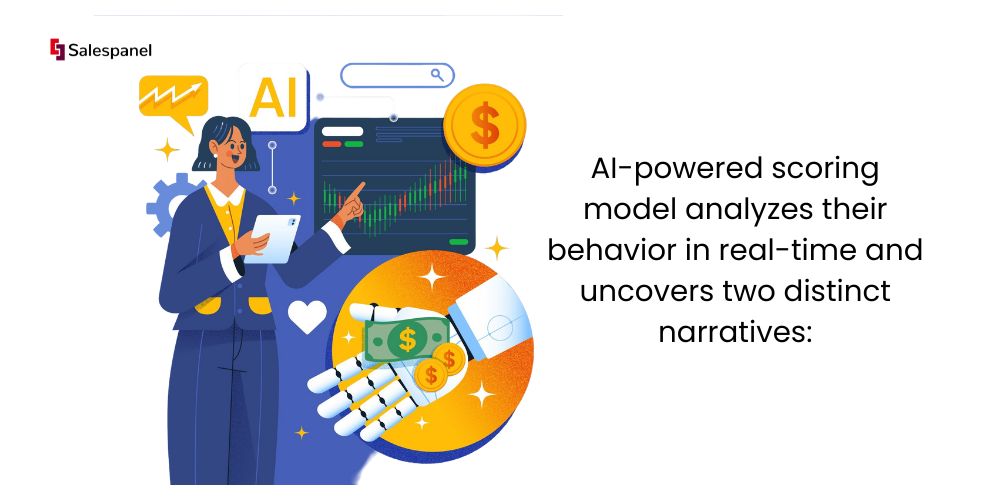
- Prospect A: Lands on the homepage from a paid ad, clicks directly to the pricing page, spends 30 seconds there, and exits the site.
- Prospect B: Arrives via an organic search for a problem-specific keyword, reads a blog post, downloads a technical whitepaper, watches a customer testimonial video, and then navigates to two case studies relevant to their industry.
Having analyzed the journeys of thousands of previously successful deals, the AI model instantly recognizes Prospect B’s behavior as a high-intent pattern strongly correlated with conversion. Based on these findings, it assigns them a significantly higher predictive lead score, ensuring that sales resources are allocated to converting them with maximum efficiency.
How AI Weighs Thousands of Data Points
Predictive lead scoring goes beyond analyzing a handful of attributes and instead focuses on simultaneously processing thousands of variables. This includes a rich blend of firmographic, demographic, and, most critically, behavioral data. The system is dynamic, continuously learning and refining its predictive algorithm with every new data point and sales outcome.
In short, AI doesn’t just ask “who are they?” but “what are they doing, and what does it mean?”
This infographic illustrates the quantifiable impact of shifting to AI-driven strategies.
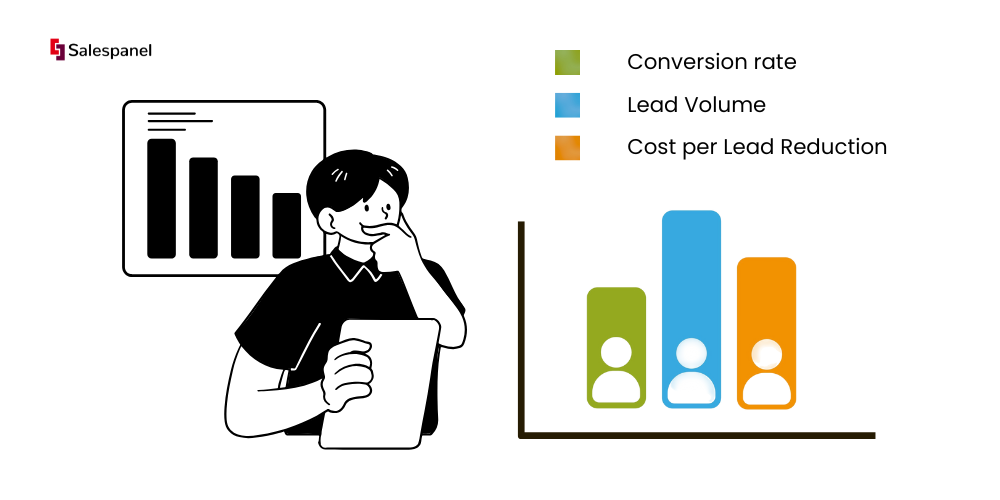
The data is unequivocal: businesses leveraging AI see significant improvements not only in lead volume but also in conversion efficiency and cost reduction, proving the direct correlation between this approach and a healthier sales pipeline for your business.
Traditional vs AI-Powered Lead Scoring
To better understand this evolution, let’s compare the methodologies side by side.
| Feature | Traditional Lead Scoring | AI-Powered Lead Scoring |
|---|---|---|
| Methodology | Static, rules-based system with manual point assignments (e.g., +5 for title). | Dynamic, adaptive model that learns from historical sales data and real-time behavior. |
| Data Inputs | Primarily explicit data, such as job title, company size, industry, and form submissions. | Combines explicit data with behavioral signals, such as pages visited, content downloaded, email engagement, and more. |
| Accuracy | Prone to errors and false positives. Misinterprets intent based on superficial traits. | High accuracy in predicting conversion likelihood. Identifies genuine buying signals. |
| Business Impact | Leads to wasted sales effort on low-quality leads and missed opportunities with high-intent prospects. | Optimizes sales team efficiency, shortens the sales cycle, and boosts conversion rates. |
The distinction is clear: Traditional scoring provided a static map, while AI offers a constantly updating GPS that guides your sales team directly to its most promising destinations.
In case you are still not convinced about the power of predictive lead scoring, here are some statistics from SuperAGI that prove its effectiveness:
- Using AI-powered predictive lead scoring has helped HubSpot increase conversion rates by up to 20% and reduce wasted effort on low-quality leads
- Companies using predictive lead scoring can, in fact, experience a 25% increase in conversion rates compared to those that don’t, according to a recent Marketo study
- Salesforce reported that its Einstein AI-powered predictive lead scoring feature has helped customers reduce the time spent on lead qualification by up to 30%
By analyzing a wide spectrum of behavioral analytics data—from email opens and social media engagement to content downloads—these algorithms prioritize leads with far greater accuracy. This enhances team efficiency while also directly fueling revenue by minimizing wasted effort.
Platforms like Salespanel are designed around this philosophy of deep behavioral insights driving modern marketing and sales. By capturing and interpreting first-party data and real-time user actions, you provide the high-quality fuel necessary for an AI engine to generate precise predictions and transform a sales funnel into a predictable growth engine.
Hyper-Personalization That Actually Converts
Personalization has long been a key objective in marketing. For years, however, its most popular use case was inserting a {{first_name}} token into a generic email template.
However, this paradigm has shifted drastically since the introduction of AI into sales and marketing functions, enabling teams to craft outreach that is deeply relevant to each prospect.
This can now be achieved because AI can analyze a prospect’s entire digital footprint in real-time. The right AI lead generation system can synthesize data points from browsing history, content downloads, webinar attendance, and even public social media activity to construct a dynamic profile of what an individual is interested in at any given moment.
Crafting Outreach from Digital Footprints
The technical process begins with data aggregation. An AI model ingests information from various touchpoints—such as website analytics, CRM entries, and marketing automation platforms—to create a single, unified view of the prospect.
It then employs Natural Language Processing (NLP) algorithms to understand the context of the content they have engaged with. Did they download a whitepaper on “API security protocols” or a case study on “retail logistics optimization”? The AI categorizes the specific topics and pain points addressed in that content, helping sales reps tailor their messaging based on demonstrated interest, rather than relying on demographic assumptions.
This deep contextual understanding facilitates dynamic outreach campaigns. Thus, AI can orchestrate outreach that adapts in real-time to an individual’s unique journey.
Practical Examples of AI Personalization
Imagine two prospects from the same target industry visit your website. A legacy marketing automation system would place them into the same generic nurture sequence.
An AI-powered system, however, observes their distinct behaviors and tailors the response instantly and automatically:
- Prospect A, a CTO, reads three technical blog posts and downloads a deep-dive whitepaper on cloud infrastructure security. The AI identifies a strong technical focus and automatically triggers a follow-up email containing a link to a relevant engineering case study and an invitation to a technical webinar hosted by a solutions architect.
- Prospect B, a Marketing Director, visits the pricing page and downloads a case study about ROI in their specific industry. The AI flags this clear commercial intent and dispatches a different email, this one highlighting a customer testimonial and offering a 15-minute consultation to discuss business outcomes with a sales specialist.
This is what AI personalization brings to the table—it enables you to make real-time decisions based on a comprehensive analysis of each individual’s behavior, without requiring human input.
Here are some real-world use cases of AI personalization:
- Stitch Fix, a well-known retail brand, created AI recommendation engines to personalize clothing selections based on customer style quizzes, purchase history, and feedback. This has led to a 40% increase in repeat purchases and 75% of customers expressing higher satisfaction with AI-driven recommendations. In addition, their AI-powered inventory system has helped minimize overstocking and increase operational efficiency.
- Snowflake, a data warehousing platform, launched a hyper-personalized ABM campaign targeted at enterprise-level accounts, with messaging tailored to each individual account’s challenges and pain points. Result? A whopping 300% increase in engagement rates and around a 50% decrease in sales cycle length during that campaign.
- Netflix, everyone’s favorite OTT platform, invested in an advanced AI-powered recommendation engine that helped them create personalized top 10 rankings and curated suggestion rows, such as “Because You Watched”. This currently drives about 80% of the content watched on the platform, in addition to a 20-30% increase in content clicks and a significant reduction in churn, which is well below industry standards.
Generative AI and the Human Touch
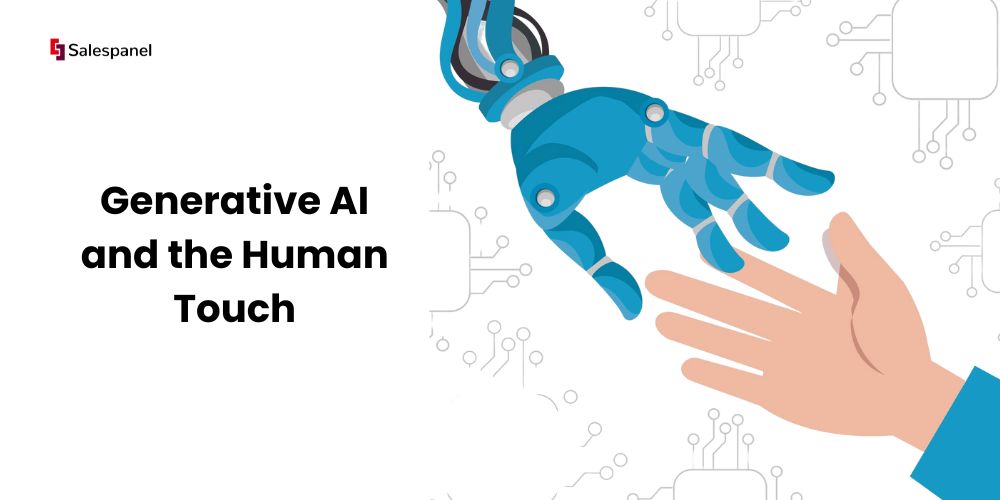
The latest advancement in AI personalization is the introduction of Generative AI. These large language models (LLMs) elevate personalization by drafting thousands of unique email variations, ensuring no two messages are identical. By analyzing a prospect’s LinkedIn profile, recent company news, and past interactions, generative AI can craft opening lines or talking points that feel remarkably human. For example, it might reference a recent article the prospect shared on social media or a new product their company just launched, creating a genuine point of connection that a template could never achieve, making it feel like a one-to-one conversation.
Remember to wield this capability responsibly, though. The most effective strategies use such insights to build trust without being intrusive. It is about demonstrating due diligence and a genuine understanding of the prospect’s professional world. True hyper-personalization is a value exchange—you use data to provide relevance, and in return, you earn their attention.
Getting Your AI Lead Generation Engine on the Road
So, how do you get started with AI lead generation? This is where concepts such as customer behavior analysis, predictive lead scoring, and hyper-personalization come into play.

Implementing an AI lead generation engine needs a structured process of establishing a foundation, installing the core technology, and fueling it with high-quality data.
Before an AI can identify your “best” leads, you must define what “best” means for your business. Are you optimizing for lead volume, lead quality, sales cycle velocity, or market penetration? Each objective requires a different configuration and set of success metrics.
Establish Data Quality Standards
The single most critical element of any AI initiative is data quality. Your AI model is a high-performance engine that requires accurate and structured data.
This is precisely why platforms like Salespanel emphasize a data-first philosophy. Before investing in an AI tool, it is imperative to have a robust system for capturing clean, first-party data and tracking user behaviors in real-time. Without this foundation, even the most sophisticated AI will generate inaccurate predictions, resulting in wasted investment
Therefore, you must begin with a data audit. Here are three key areas to focus on:
- Data Silos: Identify where customer information resides. Is it fragmented across your CRM, marketing platform, analytics tools, and various spreadsheets? Create a unified repository that can serve as a single source of truth for data.
- Data Integrity: Conduct a thorough data review. Look for duplicate contacts, incomplete profiles, and inconsistent formatting. You need clean data to train an AI model.
- Data Richness: Ensure you are tracking the right signals. You need to capture deep behavioral data that indicates intent, such as specific pages viewed, content downloaded, webinar attendance, and email engagement patterns.
Choosing the Right Tools for the Job
With a clean data foundation in place, the next step is to select the appropriate technology. The market is saturated with tools labeled “AI-powered,” but each of them supports a wide range of functionalities. The key is to select a platform that aligns with your specific business goals and integrates seamlessly with your existing technology stack.

For example, if your primary objective is to improve lead qualification, choose a tool with a proven predictive lead scoring feature. In contrast, if your goal is to scale personalized outreach, look for a platform with strong behavioral analysis and dynamic content capabilities. You must look past the marketing claims and scrutinize how a tool actually leverages data to generate actionable insights. We recommend carefully comparing each platform’s offerings and conducting proof-of-concept projects to test usability and performance.
Get Your Team Ready for an AI-Driven World
The final component is your people. Technology alone cannot produce desired results without your people there to adopt and maximize its capabilities and usage. The introduction of AI tools can be met with skepticism from sales and marketing teams, who may perceive it as a threat to their roles or another complex system to master.

Therefore, effective change management is crucial. This involves comprehensive training, clear communication about how AI will make their jobs easier and more effective, and establishing feedback loops. Your team must view AI as a collaborator—a tool that handles data-intensive analysis, allowing them to focus on the uniquely human skills of building relationships, strategic negotiation, and closing complex deals.
When your team trusts the data and understands how to leverage the insights, that is when your AI lead generation engine will achieve its full potential.
Using AI to Amplify Your Sales Team’s Impact

Let’s be clear: the ultimate objective of AI lead generation is not to replace top-performing salespeople with algorithms, but to augment their capabilities, turning them into rainmakers. The central theme of this technological shift is creating a sales environment where human talent is amplified by machine intelligence, ultimately delivering unmatched business value.
With AI algorithms executing the monotonous, data-heavy tasks, such as analyzing thousands of data points in seconds, applying predictive scoring to identify high-probability leads, and even initiating outreach with hyper-personalized messaging, your sales professionals become free from the tactical grind of manual prospecting and qualification to focus on high-value activities where human empathy, creativity, and strategic thinking are irreplaceable. These are the skills that forge strong customer relationships and close significant deals.
This combined model allows your team to dedicate their energy to:
- Building Genuine Relationships: Progressing beyond transactional conversations to become trusted strategic advisors to their clients.
- Solving Complex Problems: Engaging in deep discovery conversations to fully understand and architect solutions for a customer’s unique business challenges.
- Strategic Negotiation: Focusing on value creation and navigating complex deal structures to ensure mutually beneficial outcomes.
This vision of a sales floor where intelligent systems amplify human creativity is no longer a distant concept. The strategies detailed in this guide—from customer behavior analytics to predictive lead scoring and hyper-personalized outreach—are the practical building blocks for this new reality. By adopting AI lead generation, you will be investing in a system that elevates your most valuable asset: your people. This is the future of sales, and the best time to invest in it is now. Maximize your pipeline revenue with AI lead generation, starting today!
Got Questions About AI in Lead Generation? Here are Some FAQs.
Adopting AI-driven lead generation is a significant strategic shift, and it is natural to have questions. Let’s address some of the most frequently asked questions below.
How Much Data Do I Really Need to Get Started?
A massive, perfectly curated dataset is ideal, but it is not a prerequisite for success. A viable starting point can be a few thousand historical records—a representative mix of won and lost deals—along with several months of consistent website traffic data.
It is crucial that the quality of your data is far more important than the quantity. A smaller, cleaner dataset with accurate outcome labels will provide an AI model with much clearer signals to learn from than a vast, messy, and inconsistent one.
Can AI Actually Work for a Small Business?
Absolutely. AI can be a more significant game-changer for smaller teams. AI automates a huge portion of the manual research and lead prioritization that can overwhelm limited resources.
AI lead generation enables a small team to achieve a level of operational efficiency typically associated with much larger organizations. With the increasing affordability and user-friendliness of modern AI platforms, you no longer need an in-house team of data scientists to implement these strategies effectively.
What Are the Biggest Mistakes to Avoid?
The first mistake is the classic “garbage in, garbage out” principle. If you feed an AI platform low-quality, inconsistent, or siloed data, you will receive poor, unreliable outputs. There is no technological shortcut around this fundamental requirement.
The second major error is treating AI as a “set it and forget it” solution. The AI’s objectives must be continually aligned with your evolving business strategy and goals, and your sales team must be trained and equipped to act on the insights it generates.
Ready to stop guessing and start building a sales pipeline you can actually count on? Salespanel gives you the solid data foundation and smart tools you need to kickstart your AI lead generation engine. We help you turn anonymous visitors into real, qualified opportunities. Check out our resources and see how you can future-proof your lead generation strategy.
Sell more, understand your customers’ journey for free!
Sales and Marketing teams spend millions of dollars to bring visitors to your website. But do you track your customer’s journey? Do you know who buys and why?
Around 8% of your website traffic will sign up on your lead forms. What happens to the other 92% of your traffic? Can you identify your visiting accounts? Can you engage and retarget your qualified visitors even if they are not identified?

